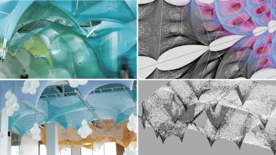
The Ergonomy of Type
Visual-performance guided font design
The typefaces that we use today are cultural artifacts with a rich history spanning over five centuries. The development of these typefaces has been influenced by various factors such as fashion, taste, ergonomy of tools, economics, and military factors. However, it remains uncertain to what extent legibility has influenced their evolution. In the modern world, text is encountered in a multitude of situations, and it is unclear whether the traditional structural proportions of letters are suitable for optimal performance in all scenarios, such as small text on interfaces and screens or long-distance reading for wayfinding.
The visual system is a complex mechanism that is prone to deterioration and whose performance varies according to factors such as size, distance, and contrast. In order to account for this variability, letters should be structurally adapted; I propose to term this exercise as "ergonomy of type”. I argue that the ergonomy of type should be defined on a continuum rather than in terms of binary alternatives, like the absence or presence of serifs, or the choice between a regular or a bold font.

As a response, this paper proposes a new experimental paradigm consisting of two elements: First, an ultra-flexible variable font, built upon a new approach to typography, that denies the value of traditional variables (weight, width, contrast...) and puts the focus on our ability to perceive variations of black and white, while simplifying data exchange among type designers and researchers. Second, a self-learning Bayesian algorithm that measures the participant's reading speed and governs the variation inside the font space, seeking the regions with the highest reading speed in a mix of exploration and exploitation.
This new methodology was applied to a reading speed paradigm for 22 participants with perfect vision with a double purpose: First, it aimed to provide new insights into the effect of typographic variables and their relation with vision and the reading layout through a series of regression models. Second, thanks to the use of a clustering method, the paradigm should be able to prototype font candidates for each of the participants.
The results of the experiment are mixed. The regression models successfully accounted for the non-interactive impact of font dimensions and were able to explain and predict reading speed through a statistically significant mixed model. On the other hand, the clustering method returned a series of candidates that had a remarkable structural similarity, indicating strong stability of the methods. However, they departed from the data suggested by the regression analysis, compromising its reliability as a prototyping tool. Although there are areas to learn from and refine, this new experimental paradigm has the computational and operational capacity to become a great asset in endeavors to expand and advance our knowledge of typography, reading and legibility.
















